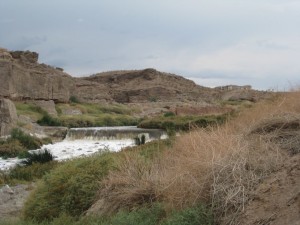Does it matter whether the current southwestern US drought is caused by anthropogenic climate change? Or, to be slightly more precise, in what ways does it or does it not matter? This isn’t a rhetorical question. Let me know what you think in the comments below.

Las Vegas Wash: perpetual water in the desert, courtesy Las Vegas, Nevada, urban sewage treatment systems. October 2010
The question arises anew in the context of the package of climate change and drought papers in PNAS this week. One of the most interesting of the bunch is by Richard Seager and Gabriel Vecchi, looking at greenhouse warming and the climate now and in the future here in the southwest.
Drawing on the IPCC AR4 model runs, Seager and Vecchi repeat a well-made point – that the poleward expansion of the planet’s arid regions is a well-understood feature of expected greenhouse climate change, and that we here in the southwest are likely to be swept up:
Among the 24 models participating in AR4, the broad agreement that SWNA (southwestern North America) will dry in the current century arises because subtropical drying and expansion are fundamental features of a warming climate. Indeed, it occurs even in idealized global atmosphere models with no surface inhomogeneities whatsoever when the opacity to longwave radiation is increased.
So is that what we already see happening? Has the shift to a new greenhouse-induced drier normal already begun?
The problem in answering that question, they argue, is that natural variability on interannual to decadal scales is large, as a result of the influence of large scale sea surface temperature patterns , and teasing out the climate change signal from that natural variability is not yet possible:
Due to the presence of large amplitude decadal variations of presumed natural origin, observations to date cannot confirm that this transition to a drier climate is already underway.
In answer to my own introductory question, I would argue that, for purposes of societal response to the drought over the 21st century here in the southwest, it does not matter. The steps we need to take as a society to adapt to a greenhouse-forced change in climate are largely the same as those we need to take to adjust to our longstanding misunderstanding of the range and depth of natural variability. Either way, we’re forced to make decisions in the face of fundamental and irreducible uncertainty with a big downside risk of a lot less water. Societal systems robust to decadal-scale droughts of the type seen in the tree ring record will also be robust to greenhouse-induced climate change.

It matters to the extent that people will react differently to what is considered part of normal variability than they will to a permanent change. People are resistant to change, especially when they see it as putting a restriction on what they consider normal. That’s why climate change deniers in the general population are so eager to hear that “the earth is always changing” or other arguments along those lines.
It is a mistake to perceive that human activity has any significant influence on either weather or climate.
From 2001 through October, 2010 the atmospheric CO2 increased by 21.8% of the total increase from 1800 to 2001 while the average global temperature has not increased significantly and the trend of the average of the five reporting agencies from 2001 through 2009 is actually down. They all report the results of their measurements on the web so anyone with a computer can check these numbers. The 21.8% CO2 increase is the significant measurement, not the comparatively brief time period.
The factors that resulted in the 20th century global temperature run-up have been discovered. Added atmospheric carbon dioxide plays a minor if not insignificant role.
A simple equation, with inputs of accepted measurements, calculates the average global temperatures since 1895 with 88% accuracy. (87.6% if it is assumed that added atmospheric carbon dioxide has no effect) See the equation, an eye-opening graph of the results and how they are derived in the pdfs at http://climaterealists.com/index.php?tid=145&linkbox=true (see especially the pdfs made public on 4/10/10 and 6/27/10).
The future average global temperature trend that this equation calculates is down.
I think you pretty well nailed it, John. In the end the cause is probably irrelevant because the tree ring record tells us that we have to be able to adapt to much larger variability in climate than we were led to expect based on the limited data-set we had been relying on for our risk-management decisions. My experience indicates that western water managers are preparing for this irrespective of the ongoing debate over climate change.